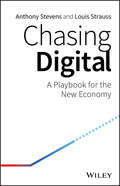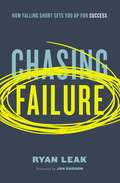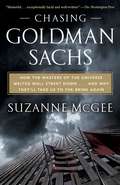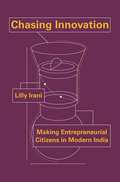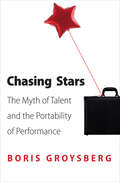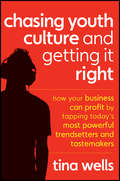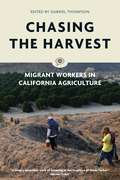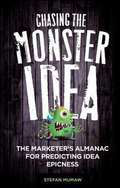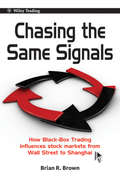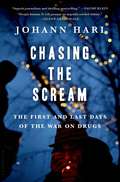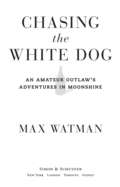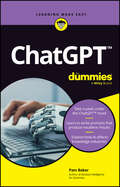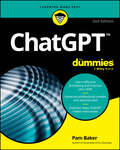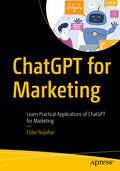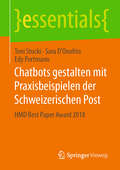- Table View
- List View
Chasing Digital: A Playbook for the New Economy
by Anthony Stevens Louis StraussLearn how to succeed in the digital economy The paradigms of big business have changed. Business models that were once lucrative now seem to barely move the needle. Incumbents of the old guard find themselves superseded by new, digitally-charged, data-fuelled organisations that leverage platform-based business models. How can pre-digital businesses survive? They’re loaded with resources, brand power and deeply embedded networks, they just need a new playbook. Chasing Digital is that playbook. Outlining a clear and detailed framework, this book is designed to help leaders re-design their organisation from the bottom up by leveraging their strengths to create a new competitive advantage in the digital economy. From laying the foundations of transformation: developing a considered strategy, growing a conducive culture and building a receptive organisational design; to building core digital capabilities: taking advantage of data, harnessing artificial intelligence and embracing appropriate platforms; to adapting the accelerators of change: navigating board expectations, mitigating potential roadblocks and making the right investments, this playbook will give you the tools and mindsets needed to not only survive but to thrive and leave a legacy for future leaders. Integrate technology into your business strategy and culture Prioritise and manage your company’s digital transition Create opportunities for fast and intentional digital growth Learn how to minimise friction with stakeholders Cut through the jargon and hype, and focus on what is critical to undertaking a truly successful, company-wide, digital transformation. In a world where digital is changing everything, Chasing Digital will help your organisation to transition beyond old business models to adopt the new digital paradigm and a new era of business. Embrace the chase.
Chasing Failure: How Falling Short Sets You Up for Success
by Ryan LeakBy blending personal stories, inspirational anecdotes, riveting psychology, get-up-and-go encouragement, and just plain practical step-by-step advice, Ryan Leak shows how chasing failure just may be the quickest way to success.We all have something we&’d love to do, but often our fear of failure outweighs the potential of our destiny. But what if we found out that failure could actually help us succeed? Through Ryan Leak&’s journey of chasing the girl of his dreams to his NBA fantasy and his encounter with five-time NBA champion Kobe Bryant, Chasing Failure helps us remove every excuse for not pursuing the life we want to live.In this book Ryan also talks about the science behind why people are afraid to fail, mixing in real-life stories and adding practical steps to help us intentionally chase failure. As he says, &“God promises to be with you always, even through the failure.&” This book is for the dreamers who have been afraid to move—and even those who have been afraid to dream. Ultimately, Chasing Failure will help us build confidence in what God has called us to do. As a motivational speaker, whether addressing people in corporations, churches, or youth events, Ryan has a message of hope: failure is right around the corner, so be brave enough to chase it! The good life is on the other side.
Chasing Goldman Sachs: How the Masters of the Universe Melted Wall Street Down ... And Why They'll Take Us to the Brink Again
by Suzanne McgeeYou know what happened during the financial crisis ... now it is time to understand why the financial system came so close to falling over the edge of the abyss and why it could happen again. Wall Street has been saved, but it hasn't been reformed. What is the problem? Suzanne McGee provides a penetrating look at the forces that transformed Wall Street from its traditional role as a capital-generating and economy-boosting engine into a behemoth operating with only its own short-term interests in mind and with reckless disregard for the broader financial system and those who relied on that system for their well being and prosperity. Primary among these influences was "Goldman Sachs envy": the self-delusion on the part of Richard Fuld of Lehman Brothers, Stanley O'Neil of Merrill Lynch, and other power brokers (egged on by their shareholders) that taking more risk would enable their companies to make even more money than Goldman Sachs. That hubris--and that narrow-minded focus on maximizing their short-term profits--led them to take extraordinary risks that they couldn't manage and that later severely damaged, and in some cases destroyed, their businesses, wreaking havoc on the nation's economy and millions of 401(k)s in the process. In a world that boasted more hedge funds than Taco Bell outlets, McGee demonstrates how it became ever harder for Wall Street to fulfill its function as the financial system's version of a power grid, with capital, rather than electricity, flowing through it. But just as a power grid can be strained beyond its capacity, so too can a "financial grid" collapse if its functions are distorted, as happened with Wall Street as it became increasingly self-serving and motivated solely by short-term profits. Through probing analysis, meticulous research, and dozens of interviews with the bankers, traders, research analysts, and investment managers who have been on the front lines of financial booms and busts, McGee provides a practical understanding of our financial "utility," and how it touches everyone directly as an investor and indirectly through the power--capital--that makes the economy work. Wall Street is as important to the economy and the overall functioning of our society as our electric and water utilities. But it doesn't act that way. The financial system has been saved from destruction but as long as the mind-set of "chasing Goldman Sachs" lingers, it will not have been reformed. As banking undergoes its biggest transformation since the 1929 crash and the Great Depression, McGee shows where it stands today and points to where it needs to go next, examining the future of those financial institutions supposedly "too big to fail."
Chasing Innovation: Making Entrepreneurial Citizens in Modern India (Princeton Studies In Culture And Technology Ser. #14)
by Lilly IraniA vivid look at how India has developed the idea of entrepreneurial citizens as leaders mobilizing society and how people try to live that promiseCan entrepreneurs develop a nation, serve the poor, and pursue creative freedom, all while generating economic value? In Chasing Innovation, Lilly Irani shows the contradictions that arise as designers, engineers, and businesspeople frame development and governance as opportunities to innovate. Irani documents the rise of "entrepreneurial citizenship" in India over the past seventy years, demonstrating how a global ethos of development through design has come to shape state policy, economic investment, and the middle class in one of the world’s fastest-growing nations.Drawing on her own professional experience as a Silicon Valley designer and nearly a decade of fieldwork following a Delhi design studio, Irani vividly chronicles the practices and mindsets that hold up professional design as the answer to the challenges of a country of more than one billion people, most of whom are poor. While discussions of entrepreneurial citizenship promise that Indian children can grow up to lead a nation aspiring to uplift the poor, in reality, social, economic, and political structures constrain whose enterprise, which hopes, and which needs can be seen as worthy of investment. In the process, Irani warns, powerful investors, philanthropies, and companies exploit citizens' social relations, empathy, and political hope in the quest to generate economic value. Irani argues that the move to recast social change as innovation, with innovators as heroes, frames others—craftspeople, workers, and activists—as of lower value, or even dangers to entrepreneurial forms of development.With meticulous historical context and compelling stories, Chasing Innovation lays bare how long-standing power hierarchies such as class, caste, language, and colonialism continue to shape opportunity in a world where good ideas supposedly rule all.
Chasing Stars: The Myth of Talent and the Portability of Performance
by Boris GroysbergIt is taken for granted in the knowledge economy that companies must employ the most talented performers to compete and succeed. Many firms try to buy stars by luring them away from competitors. But Boris Groysberg shows what an uncertain and disastrous practice this can be. After examining the careers of more than a thousand star analysts at Wall Street investment banks, and conducting more than two hundred frank interviews, Groysberg comes to a striking conclusion: star analysts who change firms suffer an immediate and lasting decline in performance. Their earlier excellence appears to have depended heavily on their former firms' general and proprietary resources, organizational cultures, networks, and colleagues. There are a few exceptions, such as stars who move with their teams and stars who switch to better firms. Female stars also perform better after changing jobs than their male counterparts do. But most stars who switch firms turn out to be meteors, quickly losing luster in their new settings. Groysberg also explores how some Wall Street research departments are successfully growing, retaining, and deploying their own stars. Finally, the book examines how its findings apply to many other occupations, from general managers to football players. Chasing Stars offers profound insights into the fundamental nature of outstanding performance. It also offers practical guidance to individuals on how to manage their careers strategically, and to companies on how to identify, develop, and keep talent.
Chasing Stars: The Myth of Talent and the Portability of Performance
by Boris GroysbergWhy corporate stars often lose their luster after changing jobsIt is taken for granted in the knowledge economy that companies must employ the most talented performers to compete and succeed. Many firms try to buy stars by luring them away from competitors. But Boris Groysberg shows what an uncertain and disastrous practice this can be.After examining the careers of more than a thousand star analysts at Wall Street investment banks, and conducting more than two hundred frank interviews, Groysberg comes to a striking conclusion: star analysts who change firms suffer an immediate and lasting decline in performance. Their earlier excellence appears to have depended heavily on their former firms' general and proprietary resources, organizational cultures, networks, and colleagues. There are a few exceptions, such as stars who move with their teams and stars who switch to better firms. Female stars also perform better after changing jobs than their male counterparts do. But most stars who switch firms turn out to be meteors, quickly losing luster in their new settings.Groysberg also explores how some Wall Street research departments are successfully growing, retaining, and deploying their own stars. Finally, the book examines how its findings apply to many other occupations, from general managers to football players.Chasing Stars offers profound insights into the fundamental nature of outstanding performance. It also offers practical guidance to individuals on how to manage their careers strategically, and to companies on how to identify, develop, and keep talent.
Chasing Wrongs and Rights: My Experience Defending Human Rights Around the World
by Elaine PearsonThe Australia Director at Human Rights Watch shares her experiences defending human rights – from human trafficking in Nepal to the 'drug war' in the Philippines to treatment of detainees in Papua New Guinea and in Australia – offering an extremely involving personal account of how far we&’ve come, and how far we&’ve got to go. Growing up in Perth, Elaine Pearson always dreamt of the wider world. Her British father and Singaporean-Chinese mother meant that her family extended beyond our shores, but it wasn&’t until later in life that she fully understood how her professional calling might have been influenced by personal history: she learned that her beloved maternal grandmother had been sold to an opera troupe as a child to save the family from starvation. As soon as she could, Elaine followed her interest in women&’s rights and people-trafficking, interviewing sex-workers and victims of trafficking on the streets of Bangkok and Amsterdam&’s red light district. Her experiences in Nepal and Nigeria profoundly shaped her understanding of how governments and NGOs need to protect the rights of victims, as well as how poverty, corruption and war drive trafficking in the first place. Elaine&’s story takes us on a panoramic survey of human rights across the world – into the UN committee rooms of New York and Geneva, as well as to the front-lines of Sri Lanka&’s search for those who disappeared in the country&’s civil war, examining death squad killings on the Philippines island of Mindanao and the detention of asylum seekers in Papua New Guinea. And her work on the appalling treatment of prisoners, many of whom are Aboriginal, vividly demonstrates that human rights abuses are something that happens at home as well as out in that wider world. In exploring human rights abuses and governments&’ failure to address them, Chasing Wrongs and Rights sometimes shows humanity at its worst. Just as often, though, we see people at their best – compassionate, resilient, determined. Deeply informative and inspiring, Elaine Pearson&’s story will leave you understanding how much needs to change, and how individuals can make a difference.
Chasing Youth Culture and Getting it Right: How Your Business Can Profit by Tapping Today's Most Powerful Trendsetters and Tastemakers
by Tina WellsUnderstand and market to the newest wave of millennialsWhether you're a business professional trying to decode the $43 billion youth market, a marketer looking for a message that connects, or an entrepreneur trying to develop youth-oriented products, Chasing Youth Culture and Getting It Right gives you an unparalleled field guide to the newest wave of millennials and their mindsets.Inside this unique book, you'll meet four major tribes?the Wired Techie, The Conformist But Somewhat Paradoxical Preppy, The Always-Mellow Alternative, and The Cutting-Edge Independent?and understand their key traits, likes and dislikes, and what kind of adult they will likely become.Includes many examples of companies, brands, and organizations who chased the youth demographic and got it right, or who failed to nail their audienceUnderstand such concepts as Warholism, Tweenabees, Hand-me-ups, Massclusivity, The Facebook Effect, and InstantityAuthor has won many honors and much media recognition as a young entrepreneur and youth marketer to watchWant to understand the next generation? Get Chasing Youth Culture and Getting It Right and discover how to reach this fascinating and elusive demographic.
Chasing the Bright Side: Embrace Optimism, Activate Your Purpose, and Write Your Own Story
by Jess EkstromOne flicker of hope. That’s all it takes to catapult yourself into the life you’ve always imagined.Success is not born out of skill, school, where we’re from, who we know, or what we scored on the SAT. None of us were born ready. None of us started life knowing how to fly a plane or launch a company or knit a sweater for our dog.But we are born with something more important than skills. We’re born with optimism—the initial seed for success. Optimism fuels the belief that you can be the one to create the good the world needs. But you’ve got to hone it. And practice it. And determine to live from it.In Chasing the Bright Side, Jess Ekstrom shares her own inspirational story of how optimism helped her overcome multiple challenges, and the dynamic ways her mind-set propelled her as a young entrepreneur, international speaker, and philanthropist. Do you have dreams for yourself and the world that are tucked away in your box of somedays? What would happen if today was the day you opened the box? And what if that box was the key to a better tomorrow?Jess’s journey will inspire you embrace the power of optimism in your own life, and help you reimagine your purpose so you create good in the world while fulfilling your own dreams—right where you are.
Chasing the Harvest: Migrant Workers in California Agriculture
by Gabriel ThompsonLives from an invisible community—the migrant farmworkers of the United States The Grapes of Wrath brought national attention to the condition of California’s migrant farmworkers in the 1930s. Cesar Chavez and the United Farm Workers’ grape and lettuce boycotts captured the imagination of the United States in the 1960s and ’70s. Yet today, the stories of the more than 800,000 men, women, and children working in California’s fields—one third of the nation’s agricultural work force—are rarely heard, despite the persistence of wage theft, dangerous working conditions, and uncertain futures. This book of oral histories makes the reality of farm work visible in accounts of hardship, bravery, solidarity, and creativity in California’s fields, as real people struggle to win new opportunities for future generations. Among the narrators: Maricruz, a single mother fired from a packing plant after filing a sexual assault complaint against her supervisor.Roberto, a vineyard laborer in the scorching Coachella Valley who became an advocate for more humane working conditions after his teenage son almost died of heatstroke.Oscar, an elementary school teacher in Salinas who wants to free his students from a life in the fields, the fate that once awaited him as a child.
Chasing the Monster Idea
by Stefan MumawThe latest from the author of the bestselling Caffeine for the Creative MindHow do you develop solutions that rock? Ones that surpass their initial purpose and grab an industry by its throat, turn interested parties into concept evangelists, and influence behaviors and alter perceptions? Read Chasing the Idea Monster and find out.This fun and insightful book sorts out the hallmarks of a monstrous idea by providing the author's "idea measurement" tools in the form of seven primary questions to gauge the potential of any idea. These seven questions are supported by real-world examples of ideas that succeeded in winning over their audience, as well as those that ignored the measurement and failed miserably.Features warnings and anecdotes from some of the world's most prominent creatives, marketing teams, and business professionalsA proven method for determining if an idea will be a "big idea," or else will die a painful deathAuthor is a respected industry expert whose Caffeine for the Creative Mind successfully reached an audience both in the creative community and beyondWant to get a better sense of what makes a successful idea, and how yours measures up? Start Chasing the Idea Monster and scoring big creative wins today!
Chasing the Same Signals: How Black-Box Trading Influences Stock Markets from Wall Street to Shanghai (Wiley Trading)
by Brian R. BrownConventional wisdom suggests that markets are efficient, random walks and that stock prices rise and fall with the fundamentals of the company. How then have black-box traders prospered and how do they exploit market inefficiencies? Are their strategies on their last legs or will they adapt to the new landscape amidst the global financial crisis? Chasing the Same Signals is a unique chronicle of the black-box industry's rise to prominence and their influence on the market place. This is not a story about what signals they chase, but rather a story on how they chase and compete for the same signals
Chasing the Scream: The First and Last Days of the War on Drugs
by Johann HariNew York Times Bestseller It is now one hundred years since drugs were first banned in the United States. On the eve of this centenary, journalist Johann Hari set off on an epic three-year, thirty-thousand-mile journey into the war on drugs. What he found is that more and more people all over the world have begun to recognize three startling truths: Drugs are not what we think they are. Addiction is not what we think it is. And the drug war has very different motives to the ones we have seen on our TV screens for so long. InChasing the Scream, Hari reveals his discoveries entirely through the stories of people across the world whose lives have been transformed by this war. They range from a transsexual crack dealer in Brooklyn searching for her mother, to a teenage hit-man in Mexico searching for a way out. It begins with Hari's discovery that at the birth of the drug war, Billie Holiday was stalked and killed by the man who launched this crusade--and it ends with the story of a brave doctor who has led his country to decriminalize every drug, from cannabis to crack, with remarkable results. Chasing the Scream lays bare what we really have been chasing in our century of drug war--in our hunger for drugs, and in our attempt to destroy them. This book will challenge and change how you think about one of the most controversial--and consequential--questions of our time.
Chasing the White Dog: An Amateur Outlaw's Adventures in Moonshine
by Max WatmanIn Chasing the White Dog, journalist Max Watman traces the historical roots and contemporary story of hooch. He takes us to the backwoods of Appalachia and the gritty nip joints of Philadelphia, from a federal courthouse to Pocono Speedway, profiling the colorful characters who make up white whiskey's lore. Along the way, Watman chronicles his hilarious attempts to distill his own moonshine -- the essential ingredients and the many ways it can all go wrong -- from his initial ill-fated batch to his first successful jar of 'shine. It begins in Monongahela, Pennsylvania, where drunk and armed outlaws gathered in the summer of 1794. George Washington mustered 13,000 troops to quell the rebellion, but by the time they arrived, the rebels had vanished; America's first moonshiners had packed up their stills and moved on. From these moonshiners who protested the Whiskey Tax of 1791, to the bathtub gin runners of the 1920s, to today's booming bootleg businessmen, white lightning has played a surprisingly large role in American history. It touched the election of Thomas Jefferson, the invention of the IRS, and the origins of NASCAR. It is a story of tommy guns, hot rods, and shot houses, and the story is far from over. Infiltrating every aspect of small-scale distilling in America, from the backyard hobbyists to the growing popularity of microdistilleries, Chasing the White Dog provides a fascinating, centuries-long history of illicit booze from an unrepentant lover of moonshine.
ChatGPT For Dummies
by Pam BakerLearn how the disruptive AI chatbot is going to change school, work, and beyond ChatGPT For Dummies demystifies the artificial intelligence tool that can answer questions, write essays, and generate just about any kind of text it’s asked for. This powerful example of generative AI is widely predicted to upend education and business. In this book, you’ll learn how ChatGPT works and how you can operate it in a way that yields satisfactory results. You’ll also explore the ethics of using AI-generated content for various purposes. Written by a journalist who's been on the front lines of artificial intelligence for over a decade, this book dives deep into ChatGPT’s potential, so you can make informed decisions—without asking ChatGPT for help. Learn how ChatGPT works and how it fits into the world of generative AI Harness the power of ChatGPT to help you, and avoid letting it hinder you Write queries that deliver the kind of response you want Take a look into how the ChatGPT API interacts with other tools and platformsThis just-in-time Dummies title is perfect for anyone life or career may be impacted by ChatGPT and other AI. ChatGPT is just the tip of the iceberg, and this book can help you prepare for the future.
ChatGPT For Dummies
by Pam BakerUpdated to provide a deeper and closer look at ChatGPT Expanded and extended, this new edition of ChatGPT For Dummies covers the latest tools, models, and options available on the popular generative AI platform. You'll learn best practices for using ChatGPT as a text and media generation tool, research assistant, and content reviewer. If you're new to the world of AI, you'll get all the basic know-how needed to add ChatGPT to your professional toolbox. And if you've been doing the genAI thing for a while already, this book will sharpen your skills as you apply AI to real-world projects in an ethical manner. You'll get insight on the best practice for using ChatGPT to make your life and work easier and how to write prompts that result in high-quality output. Understand what generative AI is and how ChatGPT produces human-like responses Get tips on writing effective prompts and using ChatGPT to generate sound and images Apply ChatGPT to your daily work or personal life Discover the best way to fact-check AI-generated content to avoid errors and hallucinations Anyone using ChatGPT to enhance their work—whether for professional or personal use—will get better results with ChatGPT For Dummies.
ChatGPT for Marketing: Learn Practical Applications of ChatGPT for Marketing
by Eldar NajafovExplore the capabilities of ChatGPT and gain insight on how to utilize this AI tool in your daily tasks, and marketing endeavors. This book introduces ChatGPT, covering its architecture, training process, and applications across various fields. Start by delving into the benefits of integrating ChatGPT into everyday routines, emphasizing its potential to streamline tasks, optimize time management, and provide valuable insights that can revolutionize individuals’ work approaches. You'll then look more closely at ChatGPT’s mechanics, its capabilities, limitations, and unique features. The book also outlines the best practices for utilizing ChatGPT, offering practical tips, techniques, and strategies to enhance output quality and reliability, while minimizing errors and maximizing results. You’ll focus on ChatGPT’s relevance in marketing tasks, such as generating product descriptions, creating email templates, automating social media posts, and addressing customer inquiries. The book concludes by exploring techniques for marketing with ChatGPT, including integration with other tools, data analysis, reporting, and customizing ChatGPT to meet specific marketing needs. In the end, you’ll have the knowledge and skills needed to leverage ChatGPT’s AI marketing capabilities and to harness its power for success in the digital age. What You’ll Learn Understand the concepts and workings of ChatGPT, its architecture, and the training process Apply the best practices for ChatGPT Create email templates and automate social media posts using ChatGPT Use ChatGPT for data analysis and reporting Who This Book Is For Marketing professionals, business owners and entrepreneurs, content creators, and customer service representatives
Chatbots gestalten mit Praxisbeispielen der Schweizerischen Post: HMD Best Paper Award 2018 (essentials)
by Edy Portmann Toni Stucki Sara D’OnofrioImmer mehr Unternehmen bauen Chatbots, damit ihre Kunden und Mitarbeiter in natürlicher Sprache mit den Systemen des Unternehmens kommunizieren können. Mittels Chatbots können dialogintensive Prozesse automatisiert und neue Wissensquellen erschlossen werden. Das vorliegende essential führt die Grundlagen von Chatbots ein und zeigt mit Praxisbeispielen der Schweizerischen Post, wo sie angewendet werden können, worauf bei ihrer Gestaltung geachtet werden muss und welche neuen Fähigkeiten in einem Unternehmen für deren Einsatz erforderlich sind.Die Autoren:Toni Stucki hat langjährige Erfahrungen als Softwarearchitekt. Bei der Schweizerischen Post leitet er ein Softwareentwicklungsteam, mit dem er bereits mehrere Chatbots implementiert hat. Dr. Sara D’Onofrio arbeitete als Innovation-Managerin bei der Schweizerischen Post und war bei der Chatbot-Entwicklung der IT Post mit dabei. In ihrer Dissertation beschäftigte sie sich mit der Thematik Chatbots. Prof. Dr. Edy Portmann ist Swiss Post Professor of Computer Science am Human-IST Institut der Universität Freiburg i.Üe., Schweiz, und beschäftigt sich mit Fragen rund um Informationssysteme, -verarbeitung und -beschaffung.
Chateau Pontet-Canet
by Daniel MalterThis case discusses the situation of Chateau Pontet-Canet in early 2000. Alfred Tesseron was the director and son of the owner of Chateau Pontet-Canet, a red wine producing estate in Pauillac (Bordeaux, France) and member of the fifth class of the ancient grand cru classification of the Medoc of 1855. International competition was mounting and revenues were declining even though Chateau Pontet-Canet delivered higher quality than equally classed peers. Moreover, despite receiving praise for its recent quality efforts, the chateau received criticism from the world's leading critic for being old-fashioned. Alfred Tesseron wondered whether he produced the right level of quality, whether he should follow his young winemaker's unconventional ideas for the work in the vineyard, whether he should modernize Pontet-Canet's style, and whether the institutions of Bordeaux were helping Pontet-Canet or holding it back. Consequently, Alfred Tesseron wondered how to best align his choices along these dimensions and secure Pontet-Canet's prosperity in the new millennium.
Chateau Winery (A): Unsupervised Learning
by Srikant M. Datar Caitlin N. BowlerThis case follows Bill Booth, marketing manager of a regional wine distributor, as he applies unsupervised learning on data about his customers' purchases to better understand their preferences. Specifically, he uses the K-means clustering technique to identify groups of customers who have purchased any number of 32 specific "deals" Booth offered over the year, differentiated by the wine varietal as well as its country of origin and a minimum number of bottles to purchase. Insights from this analysis may help him understand themes across the deals that can inform construction of new deals in the future. Topics include: Unsupervised learning; similarity and proximity; K-means clustering, with measures of Euclidean distance and cosine similarity; Gaussian mixture models; interpreting clusters.
Chateau Winery (B): Supervised Learning
by Srikant M. Datar Caitlin N. BowlerThis case builds directly on Chateau Winery (A). In this case Bill Booth, marketing manager of a regional wine distributor, shifts to supervised learning techniques to try to predict which deals he should offer to customers based on the purchasing behavior of those customers closest to them. Topics include: Supervised learning; collaborative filtering; K-nearest neighbor as a modeling technique; collaborative filtering with cosine similarity of customers; collaborative filtering with cosine similarity of products; comparison of different prediction models.
Chattanooga Ice Cream Division
by Carl S. SloaneSenior functional officers (marketing, manufacturing, research & development, control, and human resources) clash over alternative ideas for turning around a business in decline. The general manager is faced not only with choosing between competing ideas, but also managing conflict and determining whether his consensus-oriented style is appropriate to the needs of the situation.
Chaudhary Group: Rebuilding Nepal
by Lauren H. Cohen Christopher J. Malloy Inakshi SobtiAfter the 2015 Nepal earthquake, the Chaudhary Group, a billion-dollar conglomerate in Nepal decides to play a pivotal role in re-building the country. The Group's philanthropic arm (Chaudhary Foundation) works with stakeholders and develops a blue print for short and long- term relief measures. The management needs to address several questions as they navigate the foundations' course. What element of relief work should the foundation focus on? Should they go beyond addressing the immediate need for shelters and adopt a more holistic development plan? How should they acquire technical expertise and organize themselves to successfully execute this effort? The case focuses on how businesses can drive entrepreneurship and disaster management efforts and be agents for social change in the emerging markets grappling with institutional voids. How should they work with the government in this endeavor? How do they ensure an alignment of these efforts to the group and foundation's long-term focus areas and objectives?
